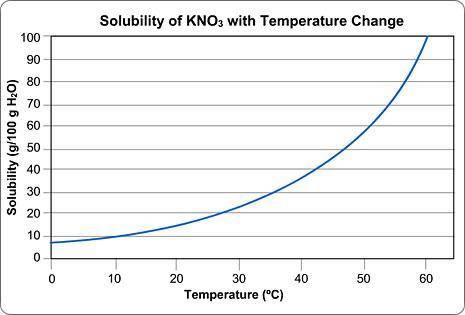Question 1 (1 point)
Above is a solubility curve for KNO3.
Solubility has nothing to do...

Chemistry, 26.02.2021 02:00 hectorgonzalejr333
Question 1 (1 point)
Above is a solubility curve for KNO3.
Solubility has nothing to do with the speed of dissolving; it's a measure of how much salt will dissolve at a given temperature.
The y-axis of the graph shows you how much KNO3 will dissolve in 100 g of water. In other words, it tells you the maximum amount of solute that will dissolve at different temperatures.
The x-axis tells you the minimum temperature needed to dissolve different amounts of KNO3 in 100 g of water.
Approximately how many grams of KNO3 will dissolve in 100 g water at 0 degrees Celsius?
Type in the number only; no units. Round your answer to the nearest whole number.
Question 1 options:
Question 2 (1 point)
Approximately what is the minimum temperature needed to dissolve 10 g of KNO3 in 100 g H2O?
Round your answer to the nearest whole number and type in the number only; no units.
Question 2 options:
Question 3 (1 point)
Imagine that you have 100g of water.
You start dissolving KNO3 in the water and you find that after you've dissolved about 55 g of KNO3, you can't dissolve any more; it just sinks to the bottom.
Approximately what is the temperature of the water?
Round your answer to the nearest whole number and submit the number only; no units.
Question 3 options:
Question 4 (1 point)
Saved
Increasing the temperature of the water will increase the amount of salt that it can dissolve.
Question 4 options:
True
False
Question 5 (1 point)
Saved
A solubility curve identifies how fast a solute will dissolve at different temperatures.
Question 5 options:
True
False
Question 6 (1 point)
Saved
This solubility curve indicates that at higher temperatures KNO3 will dissolve faster.
Question 6 options:
True
False
Question 7 (1 point)
Saved
A solubility curve tells you the minimum temperature needed to dissolve an amount of solute.
Question 7 options:
True
False


Answers: 3


Other questions on the subject: Chemistry

Chemistry, 21.06.2019 23:50, ShlomoShekelstein
Why do scientists look for patterns in the world? a. patterns can explain observations. b. patterns never change, no matter what. c. patterns are easy for scientists to detect. d. patterns are all the same, through all time.
Answers: 1

Chemistry, 22.06.2019 06:00, momof7hardings
When would a bouncy ball have the most potential energy
Answers: 2

Chemistry, 23.06.2019 01:00, crysderria
Animals that reproduce sexually either do it through external or internal fertilization. read the following statement and decide if it is true or false. birds reproduce through external reproduction which is because the female will then be able to protect the egg.
Answers: 1
You know the right answer?
Questions in other subjects:








Arts, 31.08.2019 22:20

Social Studies, 31.08.2019 22:20



